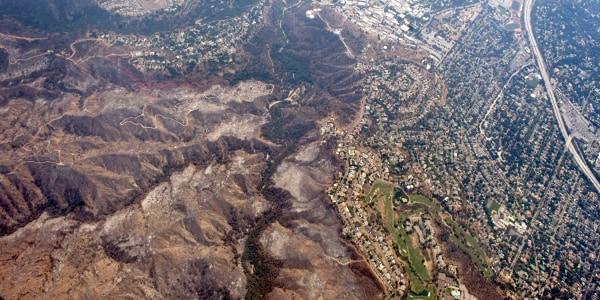Mount Wilson opened the heavens and then became a modern hub for communications on Earth. Now it is threatened by a force of nature that humans may be powerless to control.
The wildfire ravaging the mountains north of Los Angeles drew within a half-mile of the revered Mount Wilson Observatory Monday, threatening the birthplace of modern astronomy as well as a virtual forest of communication towers that serve the region.
Firefighters protecting Mount Wilson retreated Sunday but continued to dump flame retardant around the towers, transmitters and telescopes from the air. They said little could be done to stop the advancing flames, or predict how much damage would be done if the blaze ascends the 5,700-foot peak.
"Whether it runs up to Mount Wilson and does intensive burning or just burns slowly around Mount Wilson, that's up to the fire. We have no control over that," said Los Angeles County fire Capt. Mark Whaling.
Dozens of buildings are scattered around the complex, along with a trove of telescopes housed at the century-old observatory.
Firefighters worked for the past two days cutting fire lines around the most vulnerable structures. The goal was to minimize damage to the buildings, most of which are made mainly of steel and concrete.
Will TV go dark?
Virtually all of Los Angeles' TV stations — more than 20 — broadcast from an "antenna farm" on the mountain. If the antennas, transmitters or generators are damaged by the fire, the city could lose nearly all over-the-air TV broadcasts.
Viewers on satellite or cable, which is about 85 percent of the population, would be unaffected. Stations that still broadcast signals from the area might be able to transmit from other locations.
John Holland, director of engineering at KABC-TV in Los Angeles, said it's possible the TV station could stay on the air even if the fire burns through the complex. The station's antenna is sturdily built, and the transmitter at its foot is housed in a concrete building. The generator that kicks in if power is cut has several days' worth of fuel.
If the fire does enough damage to shut down the antenna, the station would be off the air for at least a few hours but KABC has a backup on the way that could provide a signal to at least part of the city, Holland said.
Most of the city's FM radio stations also broadcast from Mt. Wilson. Of the five FM stations Clear Channel Communications Inc. owns in Los Angeles, four have their antennas on the mountain. There are backup transmitters that could provide full coverage of the city, spokeswoman Michelle Clarke said.
Unlike TV and radio service, cell phone service is short-range, so any disruption from the fire would be local rather than citywide.
Birth of modern astronomy
The telescopes at the 105-year-old Mount Wilson Observatory were the premier instruments in astronomy in the first half of the 20th century, and the first to show earth its place in its universe.
There are far more modern telescopes, but the observatory is still being used to make discoveries.
Slideshow 48 photos
Blazes scorch L.A. canyons
Just a couple months ago, a Nobel Prize-winning astronomer used Mount Wilson to discover that the star Betelgeuse appears to be shrinking. In 1920, Betelgeuse was the first star to be measured — and it was done at Mount Wilson.
Mount Wilson "literally revolutionized our perception of the universe after Copernicus," said famed astronomer Wendy Freedman, director of the Carnegie Observatories, which ran Mount Wilson until 1989 when it was turned over to the Mount Wilson Institute. "It's really hard to understate the significance of Mount Wilson. These telescopes achieved something monumental."
Big Bang
Pioneering astronomer Edwin Hubble used Mount Wilson as his base of operations. In 1925, Hubble proved that the Milky Way is one of many galaxies and then found that we aren't even at the center of our own galaxy, Freedman said.
Hubble in 1929 used Mount Wilson to confirm that the universe is expanding. That led to the Big Bang theory of the universe.
Until after World War II, when newer observatories such as Mount Palomar were built, Mount Wilson was what is now the Hubble of observatories. Albert Einstein visited. At least three of Jupiter's moons were discovered there. It had the first 60-inch telescope, debuting in 1908, and the first 100-inch telescope, which first operated in 1917.
While Mount Wilson showed Earth a whole new universe, much of the time the observatory focused on one star: the sun. It was the premier solar observatory for decades and today still helps scientists understand what's going on inside our sun, said University of Southern California astronomer and physicist Ed Rhodes, who has been using Mount Wilson for more than 20 years.

